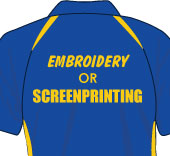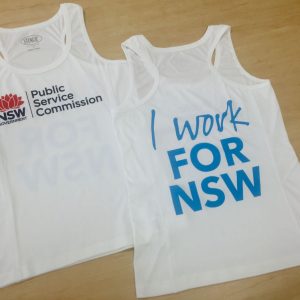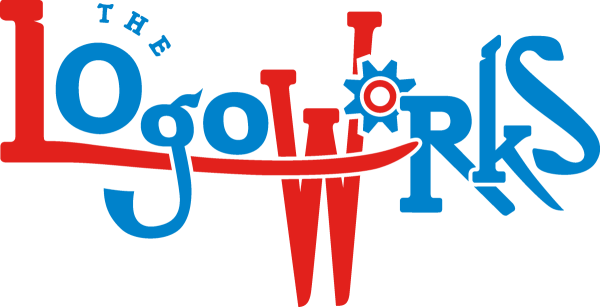
Embroidery and screen printing are the main two methods for adding logos to clothing and apparel.
With embroidery, the logo is reproduced by stitching threads directly into fabric. The actual stitching process is fully automatic and performed by computerised embroidery machines. Most commercial embroidery machines have 12 or more sewing heads with up to 15 needles per head. This means that 12 items can be embroidered simultaneously and the logo can use up to 15 thread colours. The first process is to make a program for your logo. This is called digitising. The end result is a program or logo file that can be uploaded to the embroidery machine and instructs the machine what to stitch. The garments are manually “hooped” and loaded onto the machine by the machine operator.
With screen printing, your logo is reproduced by squeezing inks through mesh screens directly onto your garments. A separate mesh screen is required for each colour in your logo so designs with many colours cost more than simple one colour designs. Just like embroidery, the screen printing process has been partly automated but garments are individually loaded and unloaded by the operator. Once printed each garment travels through a tunnel dryer which cures or sets the print.
When you are considering what decoration method to use for your garments you will probably be interested in two main things.
1. Which method is cheaper?
2. Which method is better?
Well … just read on to find out.
The Cost

Often the first thing we are asked is “which method is cheaper? The answer depends on the complexity of the logo and the quantity of garments. In general, embroidery is cheaper for pocket size logos, particularly for smaller quantities (less than 100 garments) and for logos that have several colours.
The set-up cost for most embroidered logos is a flat fee and doesn’t vary based on the number of colours in your logo. The set-up cost for screen printing is colour dependent – a new mesh screen is required for each colour in your logo. And when screen printing logos onto coloured t-shirts, a “base print” is required – think of it as an undercoat – so for example, a white print on a black t-shirt requires 2 screens. Since the set-up cost for a typical embroidered logo is about the same as the cost for a single screen, embroidery is generally cheaper to set-up.
Exceptions are large logos because they can take tens of thousands of stitches to create. They take a lot more machine time and use more thread so that makes it a lot more expensive. Screen printing large designs and logos is cheaper.
The cost scenario changes for large quantities too. The set-up costs for screen printing become incidental and printing costs become inexpensive.
Another thing to keep in mind is whether you anticipate repeat orders for the same garments. We don’t charge any set-ups for repeat embroidery jobs but we do charge reduced set-ups for repeat screen printing jobs because we have to remake the screens.
Suitability

Putting aside cost, which method will give you the best result? The answer to this question depends on the garments being decorated.
For business shirts and polo shirts embroidery is generally the best choice. Embroidery on these items is perceived as more prestigious. Embroidery is generally best for caps and outerwear too. An exception to the rule are polo shirts, typically for tradies, where a large logo is required on the back of the shirts – screen printing can be a better solution for this.
For t-shirts and lightweight garments, screen printing is the best choice. Embroidery is often too “heavy” for t-shirts and you may notice “puckering” around the logo because the stitching creates tension. Screen printing has a “softer handle” than embroidery so is much better for large logos and designs. And this suits t-shirts because they have a large decoration area on both the front and back.
In Summary
- Embroidery is the best choice for business shirts, polo shirts, caps and jackets.
- Screen printing is the best choice for t-shirts, hoodies and large logos.
(written by Andrew Robinson)
